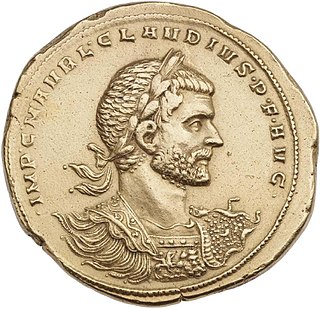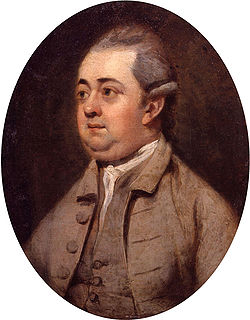
Marcus Claudius Tacitus was Roman emperor from 275 to 276. During his short reign he campaigned against the Goths and the Heruli, for which he received the title Gothicus Maximus.
The 270s decade ran from January 1, 270, to December 31, 279.

Year 271 (CCLXXI) was a common year starting on Sunday of the Julian calendar. At the time, it was known as the Year of the Consulship of Aurelianus and Bassus. The denomination 271 for this year has been used since the early medieval period, when the Anno Domini calendar era became the prevalent method in Europe for naming years.
The 250s was a decade that ran from January 1, 250, to December 31, 259.
The 260s decade ran from January 1, 260, to December 31, 269.

Aurelian was a Roman emperor, who reigned during the Third Century Crisis, from 270 to 275. As emperor, he won an unprecedented series of military victories which reunited the Roman Empire after it had nearly disintegrated under the pressure of barbarian invasions and internal revolts.

Year 273 (CCLXXIII) was a common year starting on Wednesday of the Julian calendar. At the time, it was known as the Year of the Consulship of Tacitus and Placidianus. The denomination 273 for this year has been used since the early medieval period, when the Anno Domini calendar era became the prevalent method in Europe for naming years. The year also saw most lost territories to rebellion returned to the Roman Empire by Emperor Aurelian.

Year 276 (CCLXXVI) was a leap year starting on Saturday of the Julian calendar. At the time, it was known as the Year of the Consulship of Tacitus and Aemilianus. The denomination 276 for this year has been used since the early medieval period, when the Anno Domini calendar era became the prevalent method in Europe for naming years.

Year 267 (CCLXVII) was a common year starting on Tuesday of the Julian calendar. At the time, it was known as the Year of the Consulship of Paternus and Arcesilaus. The denomination 267 for this year has been used since the early medieval period, when the Anno Domini calendar era became the prevalent method in Europe for naming years.

Year 268 (CCLXVIII) was a leap year starting on Wednesday of the Julian calendar. At the time, it was known as the Year of the Consulship of Paternus and Egnatius. The denomination 268 for this year has been used since the early medieval period, when the Anno Domini calendar era became the prevalent method in Europe for naming years.

Marcus Aurelius Claudius "Gothicus", also known as Claudius II, was Roman emperor from 268 to 270. During his reign he fought successfully against the Alemanni and decisively defeated the Goths at the Battle of Naissus. He died after succumbing to a "pestilence", possibly the Plague of Cyprian that had ravaged the provinces of the Empire.

Marcus Aurelius Probus was Roman emperor from 276 to 282. Probus was an active and successful general as well as a conscientious administrator, and in his reign of six years he secured prosperity for the inner provinces while withstanding repeated invasions of barbarian tribes on almost every sector of the frontier.

Marcus Annius Florianus, also known as Florian, was Roman emperor from the death of his half-brother, Emperor Tacitus, in July 276 until his own murder in September of that year.
This is a chronology of warfare between the Romans and various Germanic tribes between 113 BC and 596 AD. The nature of these wars varied through time between Roman conquest, Germanic uprisings and later Germanic invasions in the Roman Empire that started in the late second century BC. The series of conflicts was one factor which led to the ultimate downfall of the Western Roman Empire.

The six-volume work The History of the Decline and Fall of the Roman Empire by the English historian Edward Gibbon (1737–1794) has been reprinted many times over the years in various editions.

Ulpia Severina, also known as just Severina, was Roman empress as the wife of Roman emperor Aurelian from c. 270 to 275. Severina is unmentioned in surviving literary sources and known only from coinage and inscriptions and as a result, very little is known about her. Her nomen Ulpia suggests that she may have been related either to Emperor Trajan or the usurper Laelianus, as they share the same nomen, and perhaps from Dacia, where the name was common. It is not known when she married Aurelian, but it might have been before he became emperor. She was probably proclaimed Augusta in the autumn of 274.
Julius Placidianus was a Roman general of the 3rd century. He was a professional soldier who advanced his career under Gallienus and survived into the age of Claudius II and Aurelian. Placidianus was consul in the year 273 as the posterior colleague of Marcus Claudius Tacitus, the future emperor. His life presented here is largely derived from L.L. Howe's history of the Praetorian Prefecture.
Caenophrurium was a settlement in the Roman province of Europa, between Byzantium and Heraclea Perinthus. It appears in late Roman and early Byzantine accounts. Caenophrurium translates as the "stronghold of the Caeni", a Thracian tribe.











